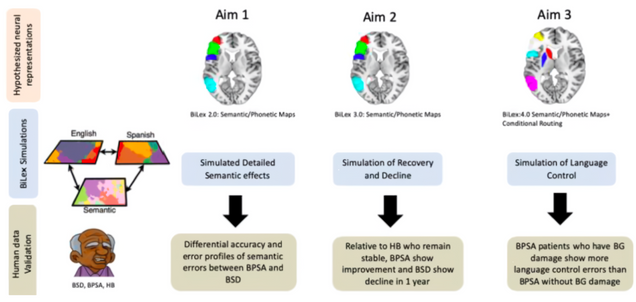Bilingual Computational Modeling for Stroke and Dementia

stroke aphasia; HB = healthy bilinguals
Figure 1. Overall schema of the project, illustrating three aims and their relationship to the hypothesized neural representation (see B.2), a schema of the BiLex architecture, and planned simulations with corresponding human data validation.
Objective: To develop advanced computational models that predict how bilingual individuals process language and how this ability is affected by post-stroke aphasia and dementia.
Background: Bilingual language processing is complex, especially in the context of neurological disorders like stroke and dementia. Factors such age of acquisition and frequency of language use can significantly influence how a bilingual individual recovers from a stroke or how their language abilities decline with dementia. Understanding these diverse manifestations is challenging without extensive clinical trials and large amounts of data. Our computational models offer an efficient solution by simulating this variability, allowing us to explore and understand the unique patterns of language impairment and recovery in bilingual individuals.
Methodology: Using computational modeling, we are creating digital twins for bilingual individuals, simulating their language ability based on their unique language experiences, impairment patterns, and brain lesion data. We then model language decline in dementia and recovery post-stroke, comparing these digital twins to real patient data to refine model accuracy.
Expected Outcomes: We aim to develop a robust computational framework to understand the diverse patterns of language processing and change over time bilingual individuals, enabling more accurate predictions of impairment, disease progression, and recovery.
Significance: This research addresses the need for effective clinical services for bilingual individuals with neurological disorders. By enhancing our understanding of bilingual processing and how it changes over time, we can develop improved diagnostic tools and personalized treatments. These advancements will significantly benefit patients, caregivers, and healthcare providers by improving care quality and outcomes for bilingual individuals affected by stroke or dementia.